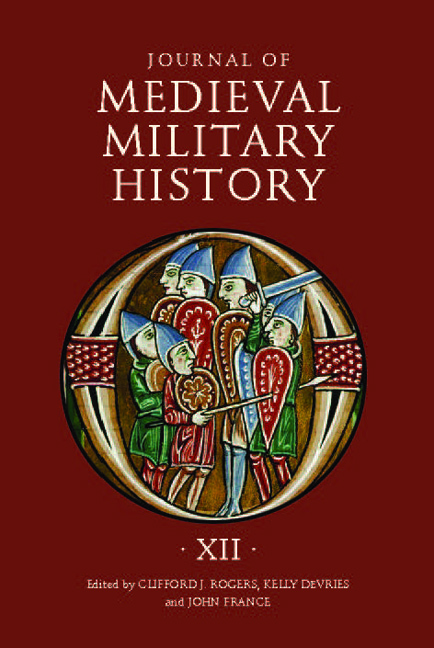Book contents
- Frontmatter
- Contents
- List of Illustrations and Map
- 1 Some Observations Regarding Barbarian Military Demography: Geiseric's Census of 429 and Its Implications
- 2 War Words and Battle Spears: The kesja and kesjulag in Old Norse Literature
- 3 The Political and Military Agency of Ecclesiastical Leaders in Anglo-Norman England: 1066–1154
- 4 Couched Lance and Mounted Shock Combat in the East: The Georgian Experience
- 5 The Battle of Arsur: A Short-Lived Victory
- 6 Prelude to Kephissos (1311): An Analysis of the Battle of Apros (1305)
- 7 Horse Restoration (Restaurum Equorum) in the Army of Henry of Grosmont, 1345: A Benefit of Military Service in the Hundred Years' War
- 8 The Indenture between Edward III and the Black Prince for the Prince's Expedition to Gascony, 10 July 1355
- 9 Investigating the Socio-Economic Origins of English Archers in the Second Half of the Fourteenth Century
- 10 War and the Great Schism: Military Factors Determining Allegiances in Iberai
- List of Contributors
- Journal of Medieval Military History 1477–545X
8 - The Indenture between Edward III and the Black Prince for the Prince's Expedition to Gascony, 10 July 1355
Published online by Cambridge University Press: 05 November 2014
- Frontmatter
- Contents
- List of Illustrations and Map
- 1 Some Observations Regarding Barbarian Military Demography: Geiseric's Census of 429 and Its Implications
- 2 War Words and Battle Spears: The kesja and kesjulag in Old Norse Literature
- 3 The Political and Military Agency of Ecclesiastical Leaders in Anglo-Norman England: 1066–1154
- 4 Couched Lance and Mounted Shock Combat in the East: The Georgian Experience
- 5 The Battle of Arsur: A Short-Lived Victory
- 6 Prelude to Kephissos (1311): An Analysis of the Battle of Apros (1305)
- 7 Horse Restoration (Restaurum Equorum) in the Army of Henry of Grosmont, 1345: A Benefit of Military Service in the Hundred Years' War
- 8 The Indenture between Edward III and the Black Prince for the Prince's Expedition to Gascony, 10 July 1355
- 9 Investigating the Socio-Economic Origins of English Archers in the Second Half of the Fourteenth Century
- 10 War and the Great Schism: Military Factors Determining Allegiances in Iberai
- List of Contributors
- Journal of Medieval Military History 1477–545X
Summary
On 19 September 1356 an English army under the command of Edward of Woodstock (1330–1376), also known as the Black Prince, won a smashing victory over a numerically superior French army led by Jean II (1319–1364). Jean II, of course, was captured. While it was unclear who could claim the honor of actually having done so, what was not in dispute was that Edward III (1312–1377) would ultimately claim the ransom. In fact, this provision was specifically spelled out in the 10 July 1355 indenture between the king and the prince. The prince was free to “have his will” of any prisoners “except only the head [chief] of the war.” In exchange, the prince would receive suitable compensation.
In addition to the ransoms of prisoners the indenture spelled out the prince's and Edward III's responsibilities and obligations. In this, it was like other indentures of the period. The indenture was, essentially, a contract for military service made between the recruiter, e.g., Edward III, and the captain, e.g., the Black Prince. The captain would then subcontract with the men in his retinue and he would pay their wages out of the moneys he had received from the king. The system of indentures, particularly for overseas service – given Edward III's foreign policy, overseas deployment was highly likely – had replaced the feudal levy before the 1350s.
- Type
- Chapter
- Information
- Journal of Medieval Military HistoryVolume XII, pp. 165 - 172Publisher: Boydell & BrewerPrint publication year: 2014



